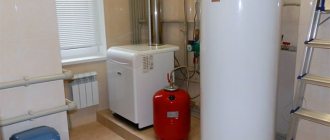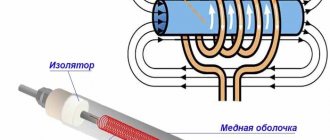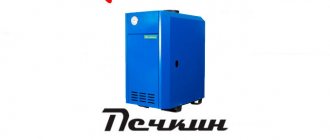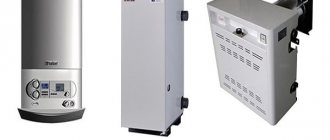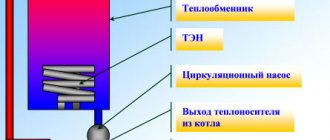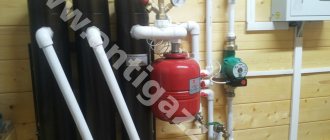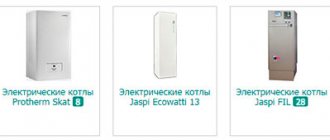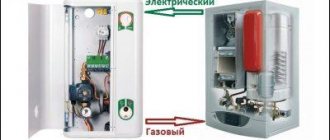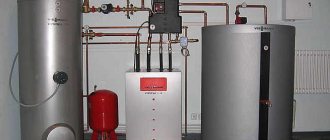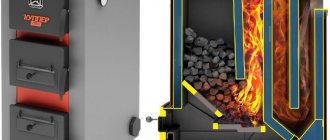An electric boiler for heating a house of 150 square meters often becomes an alternative option for those owners who do not have the ability to connect to a gas pipeline or do not want to place solid fuel units. But such equipment sometimes serves as a backup option. When purchasing a device, you need to find out its performance characteristics and pay attention to power calculations.
Requirements for an electric boiler for heating a private house with an area of 150 square meters
There are no special rules for placement of such equipment in comparison with gas and solid fuel units. Appliances must meet established standards and not pose a danger to home owners.
The main components that are included in the package include:
- circulation pump (maintains pressure in the heating circuit);
- expansion tank;
- safety valve;
- storage tank (volume varies);
- thermometer;
- air vent;
- pressure gauge
The equipment also includes various automation, sensors and other elements depending on the model.
In the event of an emergency, the device must automatically turn off.
Electric boiler power for heating 150 m2
What power should an electric boiler have to heat a private house of 150 m2? Is a thermal power reserve required for this area? Is it possible to use a low-power heating unit?
Well, firstly, the standard statement that for every 10 square meters of area you will need 1 kW of boiler thermal power, it is worth recognizing as “a little wrong.”
Why? Because the store manager who advises you doesn’t see your house, doesn’t know its heat loss, and doesn’t even know how high your ceilings are.
He, the manager, simply says “15 kW” and that’s it. That's how he was taught. What about thinking?
Look, the ceilings in the house are 220 cm and 300 cm. What difference do you think? To heat a second house with the same area and the same insulation of the building envelope, you will need an electric boiler that is almost 1.5 times more powerful.
Why? Because in the end, any heat generator, through its own heating or through radiators / heated floors, heats the air in the interior.
How is the volume of the premises and, as a result, the air in them measured? That's right, in cubic meters.
This means that it is incorrect to select the power of an electric boiler for 150 m2. And correctly - 300 m3 or 450 m3. This already depends on the height of your ceilings.
Types of electric boilers
Manufacturers offer different models: for installation on a horizontal or vertical surface. The latter are generally low-power and take up little space. Floor-standing devices are large in size; a separate room is often allocated for their placement.
Homeowners, focusing on their needs, can purchase single- or double-circuit units. If the first ones function only to heat the area, then the others are additionally capable of providing hot water supply.
In addition, devices are distinguished by the type of heating elements (although the operating principle is similar):
- Heating elements devices. They are equipped with a cylindrical body with a tungsten spiral located inside. The element itself is located in a reservoir of water; when heated, it raises the temperature of the liquid.
- Induction. Equipped with a special coil with a metal rod and cable winding. When the device is turned on, vortex flows are created in the container, which increases the temperature of the circulating water.
- Electrode. The heating elements are also located in the liquid tank. But the latter must have electrical resistance (distilled water).
Cost of thermal units using electricity
If you do not consider electric boilers with different configurations, their prices do not vary much.
With an average boiler power for your area of 16-18 kW, the cost will be from 15,000 to 25,000 rubles.
You can save a lot of money by buying a heat generator not at the end of the construction season, when everyone wants to start the CO as soon as possible, but at the very beginning.
After all, you’ve already done power calculations, haven’t you? It's time to buy an electric boiler at a discount.
Advantages and disadvantages
The advantages of such equipment are considered to be the following:
- the devices are easy to install and do not require special knowledge during operation (just read the instructions);
- absence of a chimney pipe (no harmful combustion products, which is also an environmental advantage);
- no need to install a ventilation system;
- the devices operate almost silently;
- It is possible to adjust the appropriate temperature.
Electric boilers have no disadvantages, with the exception of dependence on an uninterrupted supply of electricity.
Video description
For another point of view on induction heating boilers, watch the video:
Along with many advantages, an electric boiler also has disadvantages. First of all, this is the formation of scale on electrodes and heating elements, which occurs due to heating and sedimentation of minerals contained in the liquid. Another disadvantage is the fear of “dry” heating, when during operation air enters the container and an oxygen plug is formed. The liquid stops flowing into the tank and contacting the heating element, which leads to the heating elements burning out completely.
Installation and connection rules
The installation of the device is carried out by an organization that has the appropriate clearance and permission to carry out such work.
When installing equipment, be sure to check the grounding of the housing and the compliance of the cable cross-section. Minimum distance for installing the device:
- 0.7 m from the device to the ceiling;
- 0.7 m in front of the unit;
- 0.5 m in both directions;
- 0.5 m from equipment to floor;
- 0.3 m between the electric boiler and the wall.
The indicated indicators are standardly stated in the instructions and may differ slightly (depending on the model). Maintaining distance is necessary to ensure unobstructed access to equipment during repairs and maintenance.
After checking that the requirements are met, the specialist connects the unit and puts the device into operation. From this moment on, the person who carried out the installation bears responsibility for an emergency in the event of malfunction of the electric boiler. Therefore, self-installation is prohibited.
Gas or electric heating
When choosing between gas heating and electric, you need to take into account the quality and type of equipment installed. Users prefer more economical models, but the cost of gas and electric boilers with all components is approximately the same. The difference lies in the level of security and maintenance.
Gas appliances require supervision by specialists, unlike electric units, which are considered more reliable and safe.
Rating of popular models of electric boilers
The following devices for heating a house with an area of 150 square meters have gained the greatest demand due to their reliability and quality. m.
Kospel EKCO L2N 18
The single-circuit device has a power of 18 kW. It is equipped with electronic control and includes a display.
Efficiency is at the level of 99.4%, equipment is installed on a vertical base. The boiler is characterized by 6 power modes; the device is powered by three-phase voltage with a maximum current of 27.4 A.
The device is equipped with a room thermostat, a built-in circulation pump and a 6-liter expansion tank. The dimensions of the equipment are 418x710x251 mm (width, height, depth). Additionally, the unit is equipped with a Bypass valve.
“EVAN EPO 18”
This is also a single-circuit device with a power of 18 kW. The unit is equipped with a heating element, so it is suitable for connecting a heated floor. The efficiency of the equipment specified by the manufacturer is 99%.
The device is electronically controlled and comes with a remote control. Connects to a network with three-phase voltage, the rated current of the circuit breaker is 40 A.
Dimensions of the electric boiler – 220x565x270 mm, weight – 15 kg.
“EVAN WARMOS-M 18”
The boiler comes with 1 circuit and has a power of 18 kW. This is a heating element type unit. The efficiency of the equipment is 99%, the device is equipped with electronic control with a display. The device is mounted on the wall.
An electric boiler is characterized by 3 power levels; the equipment is connected to a network with three-phase voltage. The dimensions of the device are 380x640x245 mm, weight - 30.5 kg.
Prices: summary table
| Model | Type | Cost, rub. |
| EVAN EPO 18 | heating elementnew | 13 500-17 000 |
| RECO 18P | heating elementnew | 25 400-26 900 |
| Kospel EKCO.R2 18 | heating elementnew | 32 000-35 500 |
| Vaillant eloBLOCK VE 18 | heating elementnew | 39 900-47 000 |
| Galan Geyser 15 | electrode | 8 200-9 500 |
| Beryl-15 Ion | electrode | 9 000-13 000 |
| Alternative energy VIN-15 | induction | 50 000-62 000 |
The best option for a house of 150 m²
There is no clear answer to this question. The choice of the best boiler depends on many factors: functionality - the ability to heat the premises of the house, ease of maintenance, characteristics of the house: thermal insulation properties, distance to the nearest power supply line, gas main, cost of heating equipment, energy prices.
When taking into account the thickness of the walls, the properties of the material from which they are built are also taken into account.
When determining the best option for a particular home, the pros and cons of each boiler are taken into account. Connecting a gas heater is associated with great technical difficulties: it is necessary to have a gas main, a separate chimney, fresh air ventilation, and compliance with increased fire safety measures. Installing an electric boiler in any room is much easier.
The advantages of a gas boiler are high heating rate of the coolant, lower cost of natural gas. To heat the same volume of liquid, the cost of gas is less than the cost of electricity. In some cases, installation of gas equipment is impossible: there is no exhaust hood, no ventilation, the room does not meet fire safety standards, there are no gas communications nearby.
In an electric boiler there is no combustion chamber, no open flame, and no oxidation products harmful to the human respiratory system are released. Electric networks are more common than gas networks; electricity consumption for heating the liquid in the boiler, its cost is higher compared to the cost of gas.
In the absence of light, the boiler will not be able to heat the house
When choosing a gas boiler, several indicators are taken into account: the total area of all premises, the area where the house is located, the features of the heating system: capacity, length of lines. A higher power boiler has a larger combustion chamber and a larger heat exchanger. The efficiency of a specific model is indicated in the technical specifications.
Advantages and disadvantages
The main selection criteria include:
- A wide power range (2 - 60 kW) allows you to create a cascade heating system using several devices in conjunction, ensuring the creation of a reliable and productive heating system.
- Rational consumption of energy resources. Increased efficiency (99%) and stepwise power regulation provide increased energy savings.
- Environmental characteristics and space saving due to the absence of combustion emissions. This eliminates the need to install a boiler room and chimney.
- Control comfort. The automation provided in the package provides independent adjustment of the system operating mode. In order to increase the accuracy of response to changes in temperature conditions, many consumers additionally install room and outdoor thermostats or programmers.
- Heating the liquid. DHW preparation is carried out using a built-in and indirect hot water heating system.
Electric boilers are characterized by ease of installation, long-term and silent operation, and an affordable price.
Negative properties include the high cost of electrical energy, complete dependence on it, requiring alternative heating options and the installation of separate electrical wiring (boilers are connected to three-phase power). The latter option depends on the capabilities of the local electrical network.
Lemax gas boilers for 150 sq.m.
Lemax Patriot-20
- Power, kWt:
20 - Number of circuits:
1 - Type:
parapet - Circulation pump:
no - Expansion tank:
no - Rating:
5.0
Advantages:
- energy dependence
- price
- economical
- simplicity
- no need for a chimney
- silent
- closed chamber
- overheat protection
Flaws:
- No
Lemax Wise 16
- Power, kWt:
16 - Number of circuits:
1 - Type:
floor - Network phasing:
1 - Circulation pump:
no - Expansion tank:
no - Rating:
5.0
Advantages:
- powerful
- price
- protection of the heat exchanger from corrosion
- thick metal boiler
- ability to work under voltage surges
Flaws:
- No
Lemax Premium-12.5N
- Power, kWt:
12.5 - Number of circuits:
1 - Type:
floor - Circulation pump:
no - Expansion tank:
no - Rating:
5.0
Lemax Premium-20
- Power, kWt:
20 - Number of circuits:
1 - Type:
floor - Circulation pump:
no - Expansion tank:
no - Rating:
5.0
Advantages:
- reliability
- high efficiency
- powerful
- silent
- easy to clean
- does not depend on electricity
- price
- build quality
Flaws:
- No
Lemax Premium-12.5
- Power, kWt:
12.5 - Number of circuits:
1 - Type:
floor - Circulation pump:
no - Expansion tank:
no - Rating:
5.0
Advantages:
- powerful
- easy controls
- easy to clean
- blow-out protection
Flaws:
- No
Lemax Premium-10N
- Power, kWt:
10 - Number of circuits:
1 - Type:
floor - Circulation pump:
no - Expansion tank:
no - Rating:
4.0
Lemax Patriot-16
- Power, kWt:
16 - Number of circuits:
1 - Type:
parapet - Circulation pump:
no - Expansion tank:
no - Rating:
4.5
Advantages:
- energy independence
- low gas consumption
- price
- ease of installation and configuration
Flaws:
- No
Lemax Premium-16N
- Power, kWt:
16 - Number of circuits:
1 - Type:
floor - Circulation pump:
no - Expansion tank:
no - Rating:
4.5
Lemax Premium-16
- Power, kWt:
16 - Number of circuits:
1 - Type:
floor - Circulation pump:
no - Expansion tank:
no - Rating:
4.5
Advantages:
- price
- silent
- protection system
- ease of cleaning the boiler
- ease of use
Flaws:
- No
Lemax Premium-10
- Power, kWt:
10 - Number of circuits:
1 - Type:
floor - Circulation pump:
no - Expansion tank:
no - Rating:
4.5
Advantages:
- price
- compact dimensions
- good efficiency, economical
- silent
- modern security system
- the boiler is easy to clean
- powerful
Flaws:
- custom reviews
- Periodically you need to monitor the condition of consumable parts
Liquid fuel boilers Kiturami for 150 sq.m.
Kiturami Turbo 13R
- Power, kWt:
15.1 - Number of circuits:
2 - Type:
floor - Network phasing:
1 - Rating:
5.0
Advantages:
- price
- compactness
Flaws:
- efficiency is not true
- The chimney supplied with the model is wider in diameter than required
- no official representation
Kiturami Turbo 17R
- Power, kWt:
19.8 - Number of circuits:
2 - Type:
floor - Network phasing:
1 - Rating:
4.0
Advantages:
- price
- automatic temperature control with remote control
- gear pump
Flaws:
- noise
- poor implementation of hot water supply
- rapid breakdown of all sensors
- injectors often clog
- runs only on diesel engines not lower than Euro 5
Kiturami TURBO HI FIN 17
- Power, kWt:
19.8 - Number of circuits:
2 - Type:
floor - Network phasing:
1 - Rating:
3.0
Advantages:
- independent work due to automation
- no need to constantly heat
Flaws:
- high cost of repairs
- picky about fuel quality and correct settings
Liquid fuel boilers Navien for 150 sq.m.
Navien LFA 13K
- Power, kWt:
13 - Number of circuits:
2 - Type:
floor - Network phasing:
1 - Rating:
5.0
Advantages:
- quiet
- price
Flaws:
- high cost of solariums
- coaxial chimney
- Fuel freezes at -30
- impossibility of independently collecting fuel from depth
- There is no standard connector for connecting to a GSM remote control system
Combination boilers Teplodar for 150 sq.m.
Teplodar Cooper OVK 18
- Power, kWt:
18 - Number of circuits:
1 - Type:
floor - Rating:
4.5
Advantages:
- price
- burns smoothly
Flaws:
- There's a lot of soot from wet wood
- burns out quickly
Teplodar Kupper OK 9
- Power, kWt:
9 - Number of circuits:
1 - Type:
floor - Rating:
3.0
Advantages:
- small size
- presence of heating element
- thermal insulation
Flaws:
- small firebox
- noisy
Teplodar Kupper OK 20
- Power, kWt:
20 - Number of circuits:
1 - Type:
floor - Rating:
3.5
Advantages:
- multifunctional
- reliable
- quality materials
Flaws:
- price without standard burner
- without strapping
- cannot be placed close to the wall
- the boiler must not overheat
Solid fuel boilers NMK for 150 sq.m.
NMK Sibir-Gefest KVO 15 TE
- Power, kWt:
15 - Number of circuits:
1 - Type:
floor - Rating:
3.0
Advantages:
- huge firebox in volume and length
- convenient loading
- compact
- quickly gains temperature
- chimney versatility
Flaws:
- quality
- not convenient to clean
